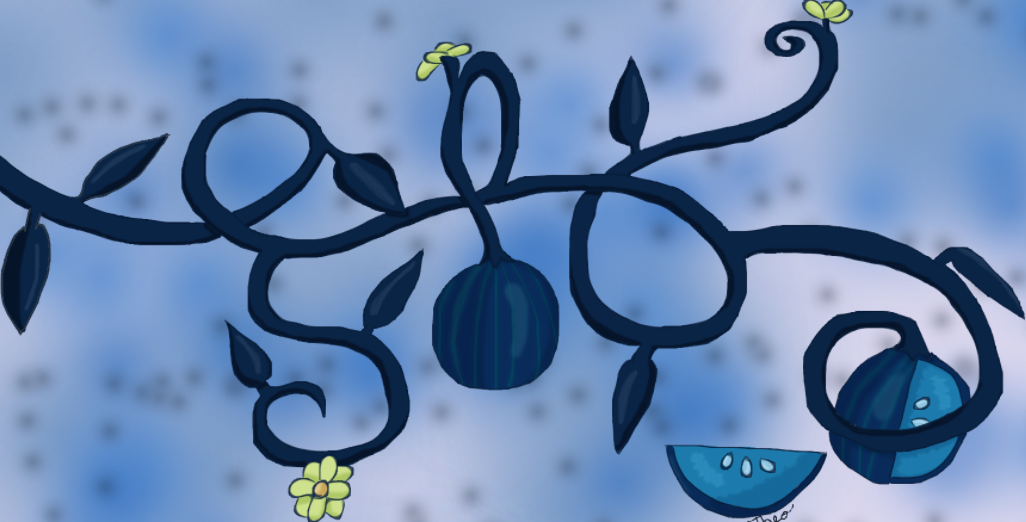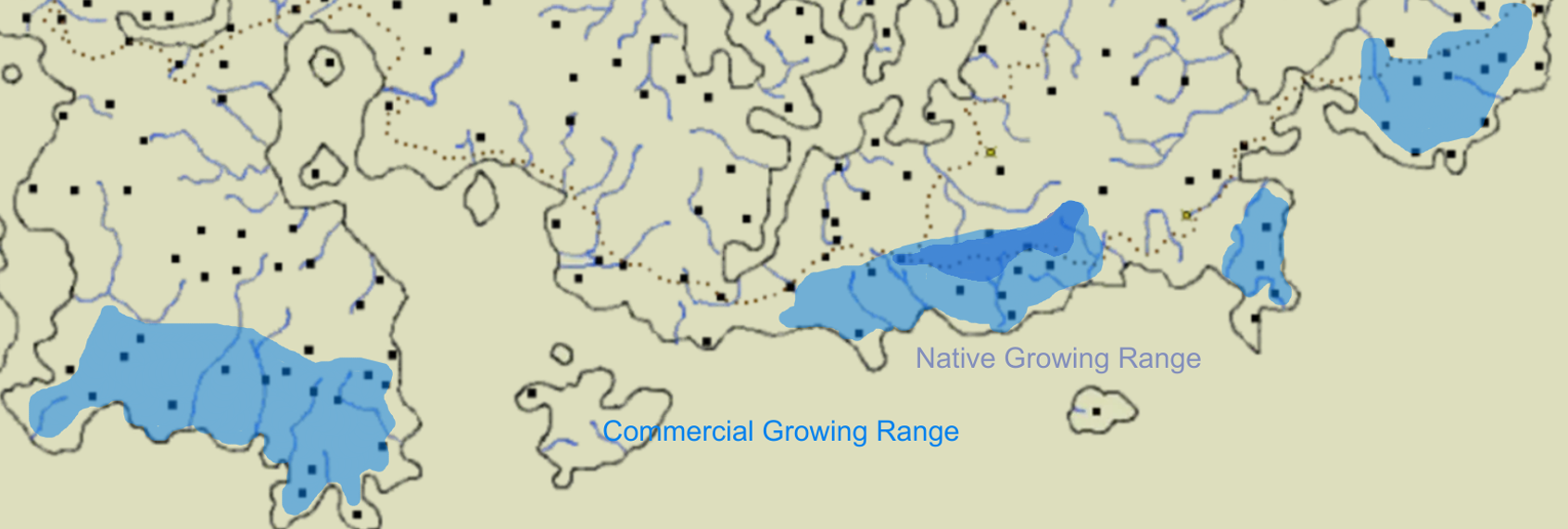Ta'ia Melon Plant
All art is by me (Theo/invadersforever) unless otherwise stated. <3
Ta'ia melon is one of the most popular fruits in Faerie. The distinctive blue-striped melons have a tough texture and a slightly sour flavour, which makes them popular in both sweet and savoury dishes. Ta'ia melons originated from the Southern regions of Faerie , and are most commonly grown in Gracia.
"But the beauty of this fruit was soon outmatched by it's own flavour! Ti [themself] was overwhelmed by the delicate, yet sour taste of [their] creation."translated from the Glacian myth "The Creation of the Ta'ia Melon".
Basic Information
Anatomy
The ta'ia melon plant is known for its iconic colouration: every part of the plant aside from its flowers are blue. The vines, which make up the main body of the plant, can grow to be several meters long and up to 5 centimeters thick. They are a dark blue colour which almost appears black in darker settings.
The leaves are wide, long, and rounded. They are slightly lighter blue than the vines and have a glossy appearance. Ta'ia leaves can grow to a length of 7-9 centimeters, and are often 4-8 centimeters wide. The leaves are often used in religious celebrations and decoration.
The flowers are the only part of the ta'ia melon plant that aren't blue. They range from 7 to 16 centimeters in diameter and a typically pale yellow, green, or white. A few rare plants found in the Sylvan Mountains that have lavender or pink flowers. Those are now thought to be an extinct subspecies, however, since none have been found in many centuries.
The ta'ia melon itself is a large melon fruit, with distinctive blue and marine bands on its shell. When commercially grown, the fruits can be up to 20 cm in diameter and weigh up to 3 kilograms. In the wild, they more often fall in the range of 9 to 12 centimeters and 1 to 2 kilograms. The fruit's bright blue flesh has a tough texture, and a mildly sour taste which has made it very popular throughout Faerie.
The seeds of the ta'ia melon are a much lighter blue than the rest of the fruit, and are incredible poisonous unless fried three times and left to sit overnight under a full moon. Due to this, shall we say, inconvenience, the consumption of ta'ia melon seeds is very localized. However, there is a long and proud tradition of ta'ia seed dishes in northern Glacia.
Growth Rate & Stages
The ta'ia melon plant starts as a seed, which is carried from its parent plant when the fruit is eaten by small mammals or birds. If the seed survives and is dropped in a good enough location, it will sprout into a small, dark blue seedling. This seedling will grow extremely rapidly, usually reaching adult size in a few weeks.
Once the plant has reached its adult size, it begins saving energy to bloom. After a about a month, it puts out large, pale flowers to attract pollinators and fertilize its seeds. Once the seeds are pollinated, the flower dies away to allow the melon to grow. Melons typically take 2 to 3 weeks to reach full size.
After the growing season ends, the ta'ia melon plant enters the final stage of its life cycle: die back. The vines and leaves wither, and any remaining flowers or fruit shrivel up and die. Within a week of the start of die back, all that remains of the plant is great skeletal heaps of dead vines.
Ecology and Habitats
The ta'ia melon originates from the southern foothills of the Sylvan Mountains. The first recorded instance of domesticated ta'ia melon comes from a kingdom in ancient Gracia. Ta'ia melon plants are grow commercially throughout Glacia and the southern parts of the Faerie Empire. The wild plants are famous for being able to grow most anywhere, so long as enough sun and water are available. Domesticated varieties are far more picky, and prefer flat land with full sun and frequent watering.
Additional Information
Uses, Products & Exploitation
The ti'ia melon plant has two major uses: food and decoration.
Ta'ia Melon and Ta'ia Seeds have been staples of Gracian and Glacian cooking for hundreds of thousands of years. After the Faerie Empire stabilized (and stopped trying to conquer every bit of land in sight), trade between Glacia and the rest of Faerie opened for the first time in several centuries. Since then, ta'ia melon has become popular throughout Faerie.
The most popular dishes with ta'ia melon are the ta'ia melon sandwich and spiced ta'ia melon salad. The sandwich is made by marinating thick slices of melon in a mixture of oils, then stacking them with grilled ingih meat between two pieces of bread or flatbread. The salad is made of chunks of spiced ta'ia melon which are tossed with salty and savoury seasonings and garnished with silvered velair nuts. Ironically neither of these dishes are Gr/lacian in origin, with both having been invented in the northern Faerie Empire when the melons first became available.
Ta'ia melon leaves are traditionally used for religious and decorative purposes in Gracian culture. They are also commonly featured in Gr/lacian art. In many other areas, it is becoming popular to grow ta'ia melon plants in ornamental gardens due to their unusual colour and striking flowers.
In the past, ta'ia melon plants have been used to create a variety of blue dyes. However, with trade reopened in Glacia, commercially made dyes have become vastly more popular.





That's a very detailed article. I like it how it focuses on the cultural use, but also provides with some information on the biology. Out of pure curiosity, did the extinct varieties have some unique traits that the contemporary varieties do not?
Well, they weren't really studied but they were supposed to have different coloured flowers, and the fruit was probably a different flavour/texture since they weren't domesticated. Maybe smaller too, since when food plants are domesticated they are made to put out more food than wild varieties. Honestly, I haven't put much thought into it but it is interesting to think about.